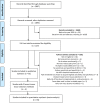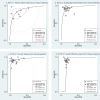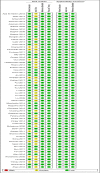Diagnostic performance of breast tumor tissue selection in diffusion weighted imaging: A systematic review and meta-analysis
- PMID: 32374781
- PMCID: PMC7202642
- DOI: 10.1371/journal.pone.0232856
Diagnostic performance of breast tumor tissue selection in diffusion weighted imaging: A systematic review and meta-analysis
Abstract
Background: Several methods for tumor delineation are used in literature on breast diffusion weighted imaging (DWI) to measure the apparent diffusion coefficient (ADC). However, in the process of reaching consensus on breast DWI scanning protocol, image analysis and interpretation, still no standardized optimal breast tumor tissue selection (BTTS) method exists. Therefore, the purpose of this study is to assess the impact of BTTS methods on ADC in the discrimination of benign from malignant breast lesions in DWI in terms of sensitivity, specificity and area under the curve (AUC).
Methods and findings: In this systematic review and meta-analysis, adhering to the PRISMA statement, 61 studies, with 65 study subsets, in females with benign or malignant primary breast lesions (6291 lesions) were assessed. Studies on DWI, quantified by ADC, scanned on 1.5 and 3.0 Tesla and using b-values 0/50 and ≥ 800 s/mm2 were included. PubMed and EMBASE were searched for studies up to 23-10-2019 (n = 2897). Data were pooled based on four BTTS methods (by definition of measured region of interest, ROI): BTTS1: whole breast tumor tissue selection, BTTS2: subtracted whole breast tumor tissue selection, BTTS3: circular breast tumor tissue selection and BTTS4: lowest diffusion breast tumor tissue selection. BTTS methods 2 and 3 excluded necrotic, cystic and hemorrhagic areas. Pooled sensitivity, specificity and AUC of the BTTS methods were calculated. Heterogeneity was explored using the inconsistency index (I2) and considering covariables: field strength, lowest b-value, image of BTTS selection, pre-or post-contrast DWI, slice thickness and ADC threshold. Pooled sensitivity, specificity and AUC were: 0.82 (0.72-0.89), 0.79 (0.65-0.89), 0.88 (0.85-0.90) for BTTS1; 0.91 (0.89-0.93), 0.84 (0.80-0.87), 0.94 (0.91-0.96) for BTTS2; 0.89 (0.86-0.92), 0.90 (0.85-0.93), 0.95 (0.93-0.96) for BTTS3 and 0.90 (0.86-0.93), 0.84 (0.81-0.87), 0.86 (0.82-0.88) for BTTS4, respectively. Significant heterogeneity was found between studies (I2 = 95).
Conclusions: None of the breast tissue selection (BTTS) methodologies outperformed in differentiating benign from malignant breast lesions. The high heterogeneity of ADC data acquisition demands further standardization, such as DWI acquisition parameters and tumor tissue selection to substantially increase the reliability of DWI of the breast.
Conflict of interest statement
The authors have declared that no competing interests exist.
Figures






Similar articles
-
Diffusion weighted imaging of the breast: Performance of standardized breast tumor tissue selection methods in clinical decision making.PLoS One. 2021 Jan 25;16(1):e0245930. doi: 10.1371/journal.pone.0245930. eCollection 2021. PLoS One. 2021. PMID: 33493230 Free PMC article.
-
The Role of Combined Diffusion-Weighted Imaging and Dynamic Contrast-Enhanced MRI for Differentiating Malignant From Benign Breast Lesions Presenting Washout Curve.Can Assoc Radiol J. 2021 Aug;72(3):460-469. doi: 10.1177/0846537120907098. Epub 2020 Mar 11. Can Assoc Radiol J. 2021. PMID: 32157892
-
Comparison of the diagnostic performances of diffusion parameters in diffusion weighted imaging and diffusion tensor imaging of breast lesions.Eur J Radiol. 2013 Dec;82(12):e801-6. doi: 10.1016/j.ejrad.2013.09.001. Epub 2013 Sep 13. Eur J Radiol. 2013. PMID: 24099642
-
Differentiating the lung lesions using Intravoxel incoherent motion diffusion-weighted imaging: a meta-analysis.BMC Cancer. 2020 Aug 24;20(1):799. doi: 10.1186/s12885-020-07308-z. BMC Cancer. 2020. PMID: 32831052 Free PMC article.
-
A Meta-analysis of the Diagnostic Performance of Diffusion MRI for Breast Lesion Characterization.Radiology. 2019 Jun;291(3):632-641. doi: 10.1148/radiol.2019182510. Epub 2019 Apr 23. Radiology. 2019. PMID: 31012817
Cited by
-
Non-contrast Breast MR Imaging.Radiol Clin North Am. 2024 Jul;62(4):661-678. doi: 10.1016/j.rcl.2023.12.009. Epub 2024 Mar 7. Radiol Clin North Am. 2024. PMID: 38777541 Free PMC article. Review.
-
Multiparameter MRI Model With DCE-MRI, DWI, and Synthetic MRI Improves the Diagnostic Performance of BI-RADS 4 Lesions.Front Oncol. 2021 Oct 15;11:699127. doi: 10.3389/fonc.2021.699127. eCollection 2021. Front Oncol. 2021. PMID: 34722246 Free PMC article.
-
Diffusion-weighted Imaging Allows for Downgrading MR BI-RADS 4 Lesions in Contrast-enhanced MRI of the Breast to Avoid Unnecessary Biopsy.Clin Cancer Res. 2021 Apr 1;27(7):1941-1948. doi: 10.1158/1078-0432.CCR-20-3037. Epub 2021 Jan 14. Clin Cancer Res. 2021. PMID: 33446565 Free PMC article.
-
Evaluation of the differentiation of benign and malignant breast lesions using synthetic relaxometry and the Kaiser score.Front Oncol. 2022 Oct 11;12:964078. doi: 10.3389/fonc.2022.964078. eCollection 2022. Front Oncol. 2022. PMID: 36303839 Free PMC article.
-
Factors affecting the value of diffusion-weighted imaging for identifying breast cancer patients with pathological complete response on neoadjuvant systemic therapy: a systematic review.Insights Imaging. 2021 Dec 18;12(1):187. doi: 10.1186/s13244-021-01123-1. Insights Imaging. 2021. PMID: 34921645 Free PMC article. Review.
References
Publication types
MeSH terms
LinkOut - more resources
Full Text Sources
Medical

